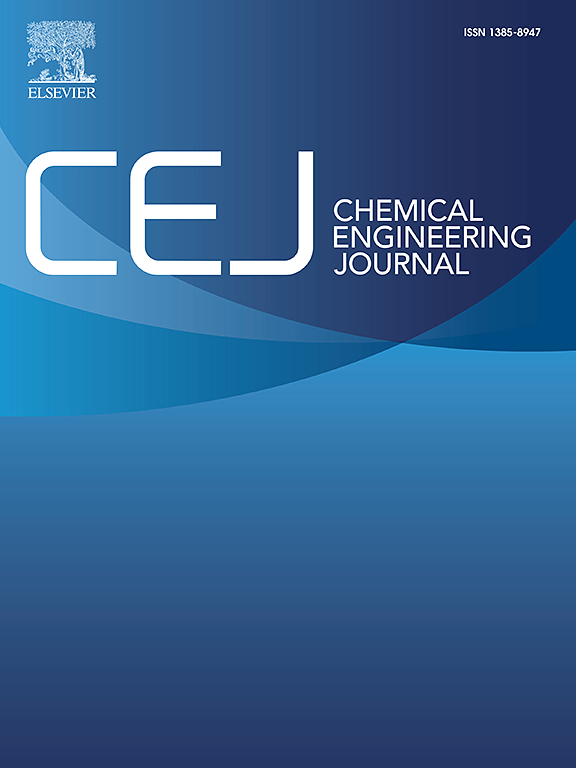Janus adhesion hydrogels with low hysteresis and high sensitivity toward precision flexible electronics underwater
IF 13.2
1区 工程技术
Q1 ENGINEERING, CHEMICAL
引用次数: 0
Abstract
High toughness and low hysteresis are crucial for stable sensing in conductive hydrogels. Moreover, these hydrogels must exhibit robust frost resistance and superior interfacial adhesion to ensure accurate signal acquisition in challenging environments. In this study, a dual-network hydrogel with Janus adhesion is developed, exhibiting exceptional mechanical properties and environmental stability. The hydrogel demonstrates an exceptional strain at break of exceeding 1000 %, a low energy dissipation rate of 10.4 %, remarkable fatigue resistance, and frost resistance. These properties stem from the collective action of dynamic borate ester bonding, hydrogen bonding, and electrostatic interactions. Its broad-spectrum adhesion is attributed to the formation of multiple bonding interactions at the interface with the substrate, while its anti-adhesive characteristics arise from the hydrophobic polymethylsilsesquioxane (PMSQ) that forms in-situ on the surface. A sensor, based on this hydrogel, exhibits high sensitivity (GF = 7.39), a rapid response time of 161 ms, and long-cycle stability of 800 cycles, enabling real-time and precise monitoring of human motion. Furthermore, this sensor enables tactile sensing and pressure distribution analysis by incorporating flexible sensor arrays. Additionally, the sensor supports underwater motion monitoring and information transmission. This study presents a novel approach to the advancement of multifunctional Janus hydrogels for next-generation flexible electronics.

Janus黏附水凝胶具有低滞后和高灵敏度的水下精密柔性电子器件
高韧性和低迟滞是导电水凝胶稳定传感的关键。此外,这些水凝胶必须具有强大的抗冻性和优异的界面附着力,以确保在具有挑战性的环境中获得准确的信号。在这项研究中,开发了一种具有Janus粘附的双网络水凝胶,具有优异的机械性能和环境稳定性。水凝胶的断裂应变超过1000 %,能量耗散率低,为10.4 %,具有显著的抗疲劳性和抗冻性。这些性质源于动态硼酸酯键、氢键和静电相互作用的集体作用。其广谱粘附性归因于与底物界面形成的多重键相互作用,而其抗粘附特性源于表面原位形成的疏水聚甲基硅氧烷(PMSQ)。基于该水凝胶的传感器具有高灵敏度(GF = 7.39),快速响应时间为161 ms,长周期稳定性为800 cycles,能够实时精确地监测人体运动。此外,该传感器通过结合柔性传感器阵列实现触觉传感和压力分布分析。此外,该传感器还支持水下运动监测和信息传输。这项研究为下一代柔性电子产品的多功能Janus水凝胶的发展提供了一种新的方法。
本文章由计算机程序翻译,如有差异,请以英文原文为准。
求助全文
约1分钟内获得全文
求助全文
来源期刊

Chemical Engineering Journal
工程技术-工程:化工
CiteScore
21.70
自引率
9.30%
发文量
6781
审稿时长
2.4 months
期刊介绍:
The Chemical Engineering Journal is an international research journal that invites contributions of original and novel fundamental research. It aims to provide an international platform for presenting original fundamental research, interpretative reviews, and discussions on new developments in chemical engineering. The journal welcomes papers that describe novel theory and its practical application, as well as those that demonstrate the transfer of techniques from other disciplines. It also welcomes reports on carefully conducted experimental work that is soundly interpreted. The main focus of the journal is on original and rigorous research results that have broad significance. The Catalysis section within the Chemical Engineering Journal focuses specifically on Experimental and Theoretical studies in the fields of heterogeneous catalysis, molecular catalysis, and biocatalysis. These studies have industrial impact on various sectors such as chemicals, energy, materials, foods, healthcare, and environmental protection.
 求助内容:
求助内容: 应助结果提醒方式:
应助结果提醒方式:


